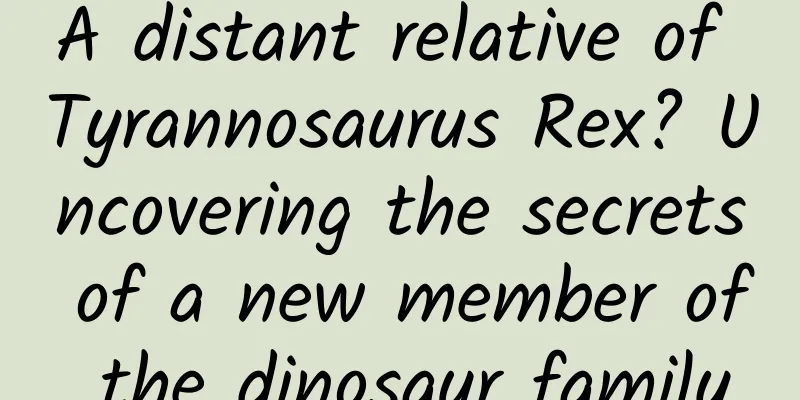A distant relative of Tyrannosaurus Rex? Uncovering the secrets of a new member of the dinosaur family

|
This fall, a study of Labocania aguillonae , from the Late Cretaceous Pueblo Mountain Formation of Mexico, emerged, suggesting that one of its relatives had finally found its long-lost cousin. The location where its fossils were discovered and the age at which it lived: it lived more than 72 million years ago. Image source: A New Tyrant Dinosaur from the Late Campanian of Mexico Reveals a Tribe of Southern Tyrannosaurs. Foss. Stud 2 (4): 245-272; doi: 10.3390/fossils2040012 01 The story of searching for relatives of Ashiyuxiasaurus Decades before the discovery of Labocania anomala, scientists discovered a relative of the same genus, Labocania anomala . The two are taxonomically the same genus, similar to the horses and donkeys we are familiar with, and they both live in Mexico. The structures of their skulls, such as the frontal bones, are also quite similar, otherwise how can they be said to be from the same family? A New Tyrant Dinosaur from the Late Campanian of Mexico Reveals a Tribe of Southern Tyrannosaurs. Foss. Stud 2 (4): 245-272; doi: 10.3390/fossils2040012 A New Tyrant Dinosaur from the Late Campanian of Mexico Reveals a Tribe of Southern Tyrannosaurs. Foss. Stud 2 (4): 245-272; doi: 10.3390/fossils2040012 Restoration of the unusual Yuxialong, source: dinosaurpics.org This "family" belongs to the Tyrannosaurus family , just like the famous Tyrannosaurus . Tyrannosaurus belongs to the Tyrannosaurus tribe under the Tyrannosaurus family, and these are another group under the Tyrannosaurus family - the Monster Hunter tribe , but they can also be considered "family members". During the last 20 million years of the Cretaceous period, Tyrannosaurus Rex and its relatives were active in many areas of the Northern Hemisphere. Some of them were large, some were small, some had long and narrow mouths, and some had large claws. Western North America is where Tyrannosaurus Rex and its relatives shine. Based on studies of skeletal morphology and evolutionary biology, the academic community divides Tyrannosaurus Rex and its relatives into different tribes, of which there are three in western North America. Note: Tribe is a classification unit, smaller than family but larger than genus. Humans and chimpanzees belong to tribe Hominidae, while cattle, buffalo, and yaks belong to tribe Bovis. The familiar cats, leopard cats (also called mountain cats), and cheetahs all belong to tribe Felidae. The author has drawn a simplified diagram of the evolutionary relationships of the dinosaurs mentioned in this article, as well as some of their characteristics. Based on references, dinosaurs in the same family are more closely related. Of course, due to limited space and for the convenience of the audience's understanding, the closeness of the relationship between the various tribes of Tyrannosaurus is not mentioned here. Does Acheron have other relatives? Teratophoneus is a typical example. This group of dinosaurs belonging to the Teratophoneus tribe lived in the southern part of North America, more precisely in the southwestern United States and Mexico. Meanwhile, the northern part of North America is home to another dinosaur family , the Daspletosaurini . This dinosaur was roughly 6-10 meters long, and its fossils were mainly found in Canada and Montana, USA. Some scholars even believe that the Daspletosaurini are the ancestors of the Tyrannosaurus dinosaurs. Skeleton of the Monster Hunter Dragon. Image source: dinosaurpictures.org Daspletosaurus dinosaur skull, source: fossilera.com The discovery of Aesculapius adds another member to the Tyrannosaurus family in western North America, a land where many talented people, young and old, gather. The academic community speculates that there may be even more Tyrannosaurus species in the area. When it comes to the age of its existence, Aesculapius is millions of years later than other anomalous Aesculapius. The latter lived from an era no less than 75 million years ago, while the former's fossils came from younger strata dating back 73-72 million years. Jaw of A. argentatus. Source: A New Tyrant Dinosaur from the Late Campanian of Mexico Reveals a Tribe of Southern Tyrannosaurs. Foss. Stud 2 (4): 245-272; doi: 10.3390/fossils2040012 02 What does Yuxialong eat every day? They are said to be relatives of the “big” Tyrannosaurus Rex, so how big are they? The type specimen of the A. sphenodon (specimen number CPC2974) discovered by the researchers is a juvenile individual , estimated to be more than 6 meters long when juvenile, with a large skull estimated to be more than 70 centimeters long. Based on another fossil including the jaw, it is inferred that these big guys can even be 9.5 meters long when they are adults. What did Ahuilasaurus eat every day? Judging from the fossils in the same stratum, there were Velafrons and Coahuilasaurus lipani , two hadrosaurid dinosaurs that might have been its delicacies. Hadrosaurs were large, duck-billed dinosaurs that ate plants like cows, sheep, deer and horses today. Averasaurus was eight meters long and had a lot of meat. There are also some ceratopsian fossils (relatives of Triceratops that Tyrannosaurus loved to eat) in the area, and it is possible that Averasaurus would have eaten them as well. Lipanicosaurus Avilasaurus reconstruction and skeleton The distribution of the small noble dragon dinosaurs in North America, of course, there are also a small number of them in northern North America Other dinosaurs from the same period as A. 03 Tyrannosaurus families scattered in other areas There are other relatives of Aesculapius. Who are they and what do they look like? Shandong Province in Asia was once the paradise of the Zhuchengtyrannus , a creature that could be more than 10 meters long, with a large, short and thick mouth, somewhat like a smaller version of the Tyrannosaurus Rex. In addition, Tarbosaurus and Alioramus were discovered in northern China and Outer Mongolia. One of these guys was ten meters long, and the other was only five to seven meters long. Alioramus had a relatively thin mouth, like a pointed-mouthed Pinocchio. Similar fossils of Zhucheng Tyrannosaurus, taken by the author at the China Geological Museum McCree's Tyrannosaurus Rex restoration image, source: zephr.newscientist.com Jiangxi Province in southern China is also home to members of the Tyrannosaurus family, where Asiatyrannus and Qianzhousaurus live. The thick-mouthed Asiatyrannus was only three or four meters long (although few Asiatyrannus fossils have been found so far, and they are still juvenile individuals). Qianzhousaurus , a "fellow countryman" of Asiatyrannus, is similar to Branchosaur in body shape, and both have long and thin mouths. Their main prey may not be the large-bodied horned hadrosaurs like their big-mouthed relatives, but the small Oviraptorosaurs, or some other small-bodied dinosaurs. When Qianzhousaurus and Asian Tyrannosaurus wandered around Jiangxi Province, they were also surrounded by distant relatives whose specific species are still unknown. These relatives are none other than the fossils of Tyrannosaurus superfamily of undetermined genus and species. Some of these unknown species are five or six meters long, and some are even larger. These "hidden creatures" who lived in the last days of the Cretaceous period might have bullied the Asian Tyrannosaurus. Reconstruction of Qianzhousaurus hunting an Oviraptorosaur, source: dinosaurpics.org Comparison of the size of Asian Tyrannosaurus and Homo sapiens, source: cosmosmagazine.com When these Tyrannosaurid dinosaurs dominated the world, they actually had distant relatives in eastern North America, members of the Dryptosauridae family. Tyrannosaurids and Dryptosauridae belong to the same superfamily of Tyrannosauroids. They had short arms and large claws, and were 6-8 meters long. Dryptosaurus and Appalachiosaurus are typical representatives of this group. A more recent reconstruction of the injured dragon. The three fingers are not obvious. Image source: carnivora.net Although the Brontosauridae occupied the east, they were also bullied at times. At that time, Deinosuchus , which belonged to the Alligatorioidea superfamily, lived in the rivers and near the seas of North America. This type of crocodile is also comparable in size to them (even 10 meters long), and some scholars have found scars on young Appalachian dragons that were bitten by Deinosuchus. It seems that sometimes, the big guys of Tyrannosaurus superfamily also have to guard against those who attack them by surprise. Brusatte, S.; Benson, R.; and Norell, M. (2011). The Anatomy of Dryptosaurus aquilunguis (Dinosauria: Theropoda) and a Review of Its Tyrannosauroid Affinities American Museum Novitates, 3717, 1-53 DOI: 10.1206/3717.2 Dromaeosauridae and Deinosuchus, source: worldanvil.com These relatives of Aesculapius eventually became extinct, but even so, a large number of their fossils still exist in the strata. Although there is no evidence of their rise and fall, time cannot take away their familiar or unfamiliar names. Their history of traveling all over the world and conquering the northern hemisphere, their linear evolution or their branching out, is still a matter of concern in today's human academic circles. References: Héctor E. Rivera-Sylva & Nicholas R. Longrich. 2024. A New Tyrant Dinosaur from the Late Campanian of Mexico Reveals a Tribe of Southern Tyrannosaurs. Foss. Stud 2 (4): 245-272; doi: 10.3390/fossils2040012 Scherer, CR; Voiculescu-Holvad, C. Reanalysis of a dataset refutes claims of anagenesis within Tyrannosaurus-line tyrannosaurines (Theropoda, Tyrannosauridae). Cretac. Res. 2024, 155, 105780. [Google Scholar] [CrossRef] Adam P. Cossette; Christopher A. Brochu (2020). "A systematic review of the giant alligatoroid Deinosuchus from the Campanian of North America and its implications for the relationships at the root of Crocodylia". Journal of Vertebrate Paleontology. 40: e1767638. doi:10.1080/02724634.2020.1767638. LiteratureLarge theropod teeth from the Upper Cretaceous of Guangdong Province, Southern China Dalman, SG, Loewen, MA, Pyron, RA et al. A giant tyrannosaur from the Campanian–Maastrichtian of southern North America and the evolution of tyrannosaurid gigantism. Sci Rep 14, 22124 (2024). https://doi.org/10.1038/s41598-023-47011-0 Longrich, NR; Ramirez Velasco, AA; Kirkland, J.; Bermúdez Torres, AE; Serrano-Brañas, CI Coahuilasaurus lipani, a New Kritosaurin Hadrosaurid from the Upper Campanian Cerro Del Pueblo Formation, Northern Mexico. Diversity 2024, 16, 531. https://doi.org/10.3390/d16090531 Carr, T., Williamson, T., Britt, B., & Stadtman, K. (2011). Evidence for high taxonomic and morphologic tyrannosauroid diversity in the Late Cretaceous (Late Campanian) of the American Southwest and a new short-skulled tyrannosaurid from the Kaiparowits formation of Utah Naturwissenschaften DOI: 10.1007/s00114-011-0762-7 RE Molnar. 1974. A distinctive theropod dinosaur from the Upper Cretaceous of Baja California (Mexico). Journal of Paleontology 48(5):1009-1017 Brusatte SL, Carr T D. The phylogeny and evolutionary history of tyrannosauroid dinosaurs[J]. Scientific Reports, 2016, 6(1): 1-8. Loewen MA, Irmis RB, Sertich JJW, et al. Tyrant dinosaur evolution tracks the rise and fall of Late Cretaceous oceans[J]. PloS one, 2013, 8(11): e79420. Brusatte, S.; Benson, R.; and Norell, M. (2011). The Anatomy of Dryptosaurus aquilunguis (Dinosauria: Theropoda) and a Review of Its Tyrannosauroid Affinities American Museum Novitates, 3717, 1-53 DOI: 10.1206/3717.2 dinoanimals.com Princeton Dinosaur Atlas Author: Daqing Shenlong Editor: Dong Xiaoxian Reviewer: Liu Kun and Li Peiyuan |
>>: How does noise, the "big devil" of sound, break people's defenses?
Recommend
OTT is struggling as a third party, but IPTV is taking a backseat
If television is a man, then analog television, c...
How does QR code marketing increase the scanning rate?
In the future, data will serve as a factor of pro...
There's still half an hour before take-off, why can't I get on the plane?
When traveling by plane, many airlines recommend ...
[Live] Wang Jian, Technical Director of iFlytek Open Platform: How to create a natural human-computer interaction experience
[51CTO.com original article] Since the birth of c...
Yutong Bus and Juefei Technology jointly launched autonomous driving technology for the first time in domestic passenger buses
Recently, Juefei Technology cooperated with Yuton...
The latest regulations on holidays on March 8, 2022: Is it necessary to have a holiday on Women’s Day? Attached is the latest national holiday arrangements!
There are many holidays in our country, almost on...
How could such a large lake disappear just like that? Where can we find evidence of life on Mars?
In the long evolution of a planet, stones are bot...
2018 Mobile Video Information Stream Advertising Value Research Report
As mobile video consumption becomes more and more...
How to take demand analysis to the extreme?
Once you have a good product idea and have determ...
Second category e-commerce marketing tips, save it!
There is only one day left for the National Day h...
The most practical seed user operation method
I have been wanting to talk about the seed user o...
Zhihu Operations | Full text of 6,000 words of practical information on how to raise an account and monetize it
As a highly active community website in China, Zh...
iOS: How to catch exception?
Table of Contents 1. System Crash 2. Processing s...
How to attract new users in 2021?
The second quarter of 2020 has passed for so long...
It causes about 700 billion in losses every year! We want to reduce this number
Produced by: Science Popularization China Author:...









